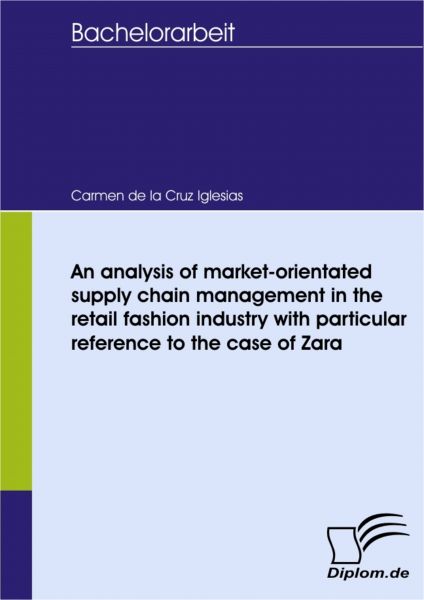An analysis of market-orientated supply chain management in the retail fashion industry with particu
Inhaltsangabe:Introduction:
A glance at today’s financial pages shows the consequences of economic recession. More and more retailers, such as Woolworth and Montgomery Ward, have become bankrupt as they were no longer good enough to compete for a customer’s business. Or how Ander and Stern describe it ‘They fell into the Black Hole of Retailing, the place where losing retailers go to die’.
However, it has been widely acknowledged that an effective downstream-orientated supply chain, focused on cost reduction, can avoid this fate. Reduced costs lead to reduced prices and thus to satisfied customers. But that is only half the truth. There are other factors than stringent cost control that ensure business success. Supply chain management is not only about cost-efficiency rather than flexibility and adaptability. The faster a supply chain is able to respond to a market, the better the company’s chances to achieve a competitive edge.
A paradigm for a company that manages to combine these aspects and to align its vertically integrated supply chain to the demands of its customers is Europe’s fastest expanding international fashion retail group Industria de Diseño Textil with its workhorse Zara. Its unique integrated business model permeates the whole organization and provides evidence that market orientation paired with an outstanding supply chain management can be viewed as a key factor for success.
Aim and objectives:
The aim of this report is to examine Zara’s unique business model in relation to its market-orientated supply chain. In this framework certain questions are raised. For example, which elements of Zara’s supply chain make it so unique? And related to this, how manages Zara to compete with other vertically integrated fashion retailers such as H&M and Benetton that use aggressive advertising to entice customers in their stores? Also, how does Zara integrate its market orientation in its supply chain? The present study will attempt to answer these and other questions. Research the success of Zara’s market-orientated strategy as well as of its unconventional supply chain will help to figure out how they managed to become pioneer of fast fashion. To conclude, an outlook in Zara’s future as well as the US market is provided. Inhaltsverzeichnis:Table of Contents:
Table of Figures4
Table of Appendix5
1.Introduction6
2.Aim and objectives6
3.Literature Review7
3.1The global fashion industry7
3.2Market orientation8
3.3The merger of market […]
Inhaltsangabe:Introduction:
A glance at today’s financial pages shows the consequences of economic recession. More and more retailers, such as Woolworth and Montgomery Ward, have become bankrupt as they were no longer good enough to compete for a customer’s business. Or how Ander and Stern describe it ‘They fell into the Black Hole of ...
Versandkostenfreie Lieferung! (eBook-Download)
Als Sofort-Download verfügbar
- Artikel-Nr.: SW9783836632652
- Artikelnummer SW9783836632652
-
Autor
Carmen de la Cruz Iglesias
- Verlag Diplom.de
- Seitenzahl 33
- Veröffentlichung 10.07.2009
- Barrierefreiheit
- ISBN 9783836632652
- Verlag Diplom.de

